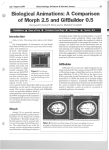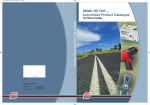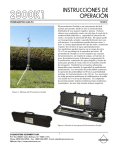Download Using the Software Package Mathcad As a Tool to Teach Soil Physics
Transcript
Using the Software Package "MathCAD" as a Tool to Teach Soil Physics D. K. Cassel* and D. E. Elrick ABSTRACT Many students avoid taking a course in soil physics because they are apprehensive about higher mathematics. The computer software, MathCAD, one of several "toolbox software programs" for solving mathematics problems, was used extensively in teaching a graduate course on water and solute transport. Students gained proficiency using the software as homework assignments gradually became more complex. Students solved simple arithmetic problems such as the computation of bulk density and water content, problems of intermediate difficulty such as graphing functions to describe the concentration of a nonreactive chemical species in the effluent of a soil system, and complex problems such as nonlinear curve fitting to construct a smooth curve through experimental data. A survey 7 mo after the course was completed indicated that students found MathCAD easy to learn, the software allowed the student to focus on physics rather than mathematics, and some of the students planned to continue using MathCAD to solve problems in other courses and in their research. S on, PHYSICS is perceived by many students to be a very difficult subject. Indeed, most practicing agronomists and soil scientists, as well as graduate and advanced undergraduate students in these disciplines, equate "soil physics" with "advanced mathematics." This situation arises because mathematics is a necessary tool for stating the relationships among variables to describe a particular physical state or process. Problems involving O.K. Cassel, Dep. of Soil Science, Box 7619, North Carolina State Univ., Raleigh, NC 27695-7619; and D.E. Elrick, Dep. of Land Resource Science, Univ. of Guelph, Guelph, Ontario, NIG 2W1, Canada. Received 19 Mar. 1991. *Corresponding author. Published in J. Nat. Resour. Life Sci. Educ. 21:74-78 (1992). 74 • J. Nat. Resour. Life Sci. Educ., Vol. 21, no. 1, 1992 water transport, for example, may require the solution of a partial differential equation, or in the case of drainage, the use of complex variables. It is our belief that students worry less about the "physics" than they do about the mathematics in a soil physics course. Many students avoid soil physics courses for this very reason. Progress in overcoming students' apprehension of soil physics courses was made possible with the introduction of the book Soil Physics with BASIC by Campbell (1985). This book was designed for students who have mastered differential and integral calculus, but who have not taken a course in differential equations. Using Campbell's textbook, the student first learns the physical concepts concerning a particular process, and then solves related problems using microcomputers. This is accomplished using computer programs, coded in BASIC, which are printed in the book or available on a disk from the publisher. In addition to using the computer program provided, students are encouraged to explore various solutions to the equations using different initial and boundary conditions, and to vary the magnitudes of variables in the equations. This activity results in a deeper understanding and appreciation of the physics of the process and its sensitivity to the magnitudes of various parameters. A major advantage of this approach is that the student does not have to spend an undue amount of time making numerical calculations or having to write computer programs. Commercial computer software has become more sophisticated during the past several years. Specialized "toolbox" software programs are now available that allow users to solve mathematical problems ranging from simple algebraic operations to complex ones involving, for example, integration, differentiation, and nonlinear curve fitting. The availability of this software creates another opportunity for instructors to refine the manner in which soil physics is taught. The purpose of this article is: (i) to briefly describe someof the features of the mathematical software package "MathCAD" ~, and (ii) to show several examples how this package was used in teaching a graduate course in water and solute transport. MathCADsoftware was selected for teaching the course because of the authors’ familiarity with it. WHATIS MathCAD? MathCADis a software package for personal computers. MathCAD allows the user to write equations in standard, two-dimensional format; to use standard mathematical symbols; and to solve them. In addition, graphs in two or three dimensions can be generated. MathCAD uses standard mathematical symbols for operators and variables, including Greek symbols. To create simple expressions, such as addition or multiplication, the user enters the numbers and operators (for example + for addition and * for multiplication) using the keys on a standard keyboard. To create more complicated constructs, such as plots or definite integrals, the appropriate built-in function is selected using dedicated keys on the keyboard. The user simply fills in the designated blanks to complete the construct. For example, once the proper key has been pressed to initiate the integral construct, the user must key in four entries to fill in the following four blanks associated with the integral: (i) the expressionto be integrated, (ii) the upperlimit of integration, (iii) the lower limit of integration, and (iv) the tegrating variable. Once variables are defined and the equations or constructs are written, the program is complete and MathCAD finds the numerical solution. The defined variables and equations of the program become part of a "document" that can be printed or saved in a computer file. Documents,in pieces or in entirety, can be imported into other documents. The numerical algorithms for evaluating integrals, matrix inversion, and equation solving are standard, predictable, and robust. Commands are given from pull-down menus, by name or by dedicated keys. An editor in MathCAD allows the user to rearrange the information on the screen and to add text and labels, if desired, to create a self-explanatory documentwhen sent to a printer capable of printing graphics. The printed documentis identical in every detail to the information displayed on the monitor. monochromemonitor. No math coprocessor is required but machine operations are much faster with one. MathCADis licensed by MathSoft, Inc. MathCAD2.5 sells for about $180 (1991 price); the student version (MathCAD2.0) sells for $40. EXAMPLES The following examples were used in the soil physics course and are presented to illustrate several of the kinds of problems solved. The accompanyingfigures are actual copies of the display on the monitor. Example1: Simple Calculation Problem Statement: A cyfindrical core of wet soil having a radius of 3.7 cm and a height of 7.6 cm weighs 573 g and loses 110 g upon oven drying. Calculate bulk density and water content on a weight basis. The easiest approach to solve this simple problem is to use the keyboard in the same manner as one uses a calculator. After the numbersand operators defining the equation have been keyed in, the numerical answer appears on the screen immediately after entering the equal sign (Approach A, Fig. 1). This approach is rapid, and the information on the screen can be either saved in a data file, printed, or discarded. Problem 1: Calculation A. and WATER CONTENT - 1.416 3.7’ 3.7’ 7.6 110 ----= 0.238 573 - 110 B. Second approach: Given information: Mw := 110 g Mass of Moll Mt := 573 g Total mass r := 3.7 cm Radius of soil core L := 7.6 cm Length of soil core Volume of soil core water of wet soll 2 V := Db = ~ r L Mt - MW ....... V -3 = 1.416 gcm MW Ow : - 0.238 Mt - MW 8w = ~ The use of trade namesin this publication does not imply endorsementby the North Carolina Agric. Exp. Stn. or the University of Guelph of the products named nor criticism of similar ones not mentioned. DENSITY 573 - II0 Db - Software Specifications MathCAD 2.5 requires, at a minimum,an IBM, Apple, or compatible computer with 512 RAM,at least one 5.25 or 3.50 inch disk drive (hard disks are supported), and MS-DOS or PC-DOS2.0 or higher. It requires a graphics printer or plotter, and operates on either a color or of BULK First approach: - 23.758’% Mt - MW Fig. 1. Document showingbulk density and water content calculations and output using MathCAD. J. Nat. Resour. Life Sci. Educ., Vol. 21, no. 1, 1992 Using ApproachB to solve this problem is more satisfying (Fig. 1). The "append" commandallows the user to select one of three "scientific unit" files resident in MathCAD.For example, appending the MKS(SI) unit file allows the user to specify the units of each variable in the equation in SI units. The answer is then automatically displayed in SI units. To begin solving this problem, the numerical value for each symbol appearing in the equations to follow is defined. Each equation is then written in terms of the previously defined symbols and, immediately upon keying in the equal sign for each equation, its numerical answer and units are given. No units exist for the computer water content because the units cancel. By pressing the percent key after the unitless answer, the equation is automatically copied and the answer given in percent. The equations are essentially templates and can be used to solve the same problem repeatedly (for different sets of input data) simply changing the appropriate numerical value(s) of the variables defined in the "Given information" section in Fig. 1. This example was chosen to illustrate several MathCAD features. In practice, it would be easier and faster for a student to solve the problem on a hand-held calculator. The following two examplesillustrate the types of problems solved by graduate students using MathCAD in an AdvancedSoil Physics class at the University of Guelph during the 1990 spring semester. Noneof the students had previous experience using MathCAD before the course began. Example2: Plotting Functions Plotting the functional relationships between several variables is a powerful learning tool because the student can observe visually how a change in one or more independent variables affects the dependent variable. The concept of the breakthrough or effluent concentration curve is important in understanding solute transport in soils (Van Genuchten and Wierenga, 1986). For this problem the breakthrough curve is defined as the concentration of nonreacting solute flowing out of a soil system(e.g., out the base of a soil profile) plotted vs. p, the numberof pore volumesof fluid flowing through the soil system. Problem Statement: Plot the breakthrough curves for one-dimensional solute transport of a nonreacting chemical. The first solution, C1 (for brevity the equations are not stated here, but are shownin Fig. 2) assumes an infinite soil column (Taylor, 1953). Solutions C2 (Lapidus and Amundson, 1952) and C3 (Lindstrom et el., 1967) assume first type (concentration) and third type (flux) boundaryconditions, respectively, at the inlet end of a semi-infinite soil column. For a comparisonof these and other results, see Van Genuchten and Parker (1984). The complete program to generate 25 pairs of numbers to plot the theoretical breakthrough curves for solutions C1, C2, and C3 are shown in Fig. 2. After assigning the index variable i values for 1 to 25, the pore volume variable p, which occurs in all three equations, a := 5 B is theBrenner or columnPeclet number o.~____~ : o.ooooo~ o.r~ , .9.oo62z .,;; | o Fig. . . ! 0 2. Document showing MathCADprogram and output 76 ¯ J. Nat. Resour. Life Sci. Educ., Vol. for plotting 21, no. 1, 1992 complex functions. C2 io 1.269814 10 0.000003 C3 io 2.727263 O.eO006 is defined in terms of i. The Brenner number, B, also called the column Peclet number, is a dimensionless parameter, which represents the ratio of the convective to the dispersive processes. After typing the three equations as shown in Fig. 2, the "compute" commandis given and the four columns of data displayed in Fig. 2 are generated. The "plot" function is activated with a pre-assigned key allowing the three curves to be plotted. A wide range of plot formats can be formulated using the guidance of a pulldown menu. The average length of time required by a student learning MathCAD to generate these plots was less than l h. Once the programis run, the influence of the Brenner number on the breakthrough curves is easily obtained by typing in a new value of B. The time required to run the entire program for one value of B was 5 s using a 286 computer with math coprocessor. Example3: Nonlinear Curve-Fitting Problem Statement: Chloride concentration vs. time at the 20-cm depth was obtained by Ian van Wesenbeeck (Ph.D. student) at the Delhi Research Station in Ontario on a sandy soil. (For brevity the data are shown only in the output section of Fig. 3.) Chloride was applied to the soil surface at the rate of 80 g of chloride per squaremeter of soil surface. The average water content in the transmission zone was 0.30 mS/ms , the average bulk density was 1.59 g/cm3, and the average infiltration rate was 3.5 cm/h. Use nonlinear curve fitting to construct a smooth curve to fit the data. Presented in Fig. 3 are: (A) the data files and defined constants; (B) the program to solve for the numerical values of three parameters (~r, /~, and MPA)subject minimizing the least square mean error; (C) the computed values of the three fitting parameters; and (D) a plot of the curve along with the input data. Althoughthe program looks complex, the user manual provides a stepby-step description of the process. Reasonableguesses of the three unknownparameter values are required to begin the iterative curve-fitting process. The "plot" procedure discussed in Example2 was used to create the graph. DISCUSSION Student Response Questionnaires to assess their views about MathCAD were sent to all nine M.S. and Ph.D. students 7 moafter they had completed the advanced soil physics course. In their responses, seven students said they used the computer very often and one said often. Ona five-point scale of very easy, easy, neither easy nor difficult, difficult, or very difficult, five students found learning MathCAD was easy, and three found it neither easy nor difficult. One commented, "Once you know what the function keys do, it is easy. However,it was somewhatfrustrating at first." Additional statements were evaluated based on a fivepoint scale of strongly agree, agree, neither agree nor disagree, disagree, and strongly disagree. They agreed the user manual made it possible for them to quickly use Inputof experimental Guessvalues o :=.5 Thesearethebestguessvalues of a,thevarianGe, and~,themean, Fig. 3. Documentshowing MathCAD programfor nonlinear curve fitting. d. Nat. Resour. Life Sci. Educ., Vol. 21, no. 1, 1992 ¯ 77 MathCAD. They also agreed the plot function was easy to learn. They agreed using MathCAD made it possible to focus on the physical properties of soils without spending too much time on the math. Comments included, "It allowed me to look at the physics of the question without having to review my calculus" and "The physics aspects of soil properties and their mathematical descriptions are supplementary to each other; therefore, without one the other cannot be understood properly." Students agreed that using MathCAD helped them clarify the functional relationships between variables. They neither agreed nor disagreed with the statement, "Without MathCAD, the course would have been difficult because of the math." In their comments they expanded on their responses: "Although I have several university courses in calculus, my working knowledge of math was not to the level that would have made the physics course easy. MathCAD really helped." "Although it helped in plotting analytical solutions and varying variables, it did not help with partial differential equations." "Difficult to say—perhaps I did not realize the amount of time I would have spent without MathCAD." "To understand MathCAD's output you must understand the input." They agreed they would continue to use MathCAD, even if it were not an integral part of a course. Typical statements were: "I'm using it to analyze my thesis data" and "I'll continue to use MathCAD because it has a wide range of math functions and operations." In response to the question, "In general, how do you think MathCAD helped you learn soil physics concepts in this course?", one responded, "It helped me understand the relative importance/impact of changes in various input parameters on the output parameter, i.e., salt concentration." Other responses indicated that MathCAD had not hindered them in learning soil physics concepts in the course. Balkovick et al. (1985) found that students have difficulty translating an abstract mathematical formulation into an understanding of the phenomena that they can use. Because of computational difficulty, faculty may confine examples to problems that can be solved on the 78 • J. Nat. Resour. Life Sci. Educ., Vol. 21, no. 1, 1992 blackboard. This may limit assignments. With the computer, ".. .the students can be asked to pose a variety of 'What if?' questions about problems so sufficiently rich that not even the qualitative answers may be obvious" (Balkovick et al., 1985, p. 1215). Instructor Response We conclude that the various mathematical problemsolving procedures in MathCAD represent a powerful tool for students as well as researchers to solve complicated problems. Advantages of using MathCAD in an advanced soil physics course include the following: (i) relatively easy to learn to use, (ii) capable of solving complex equations, and (iii) relatively inexpensive. We are not promoting the idea that MathCAD or any other computer software package be substituted for learning mathematics. However, we do believe MathCAD and similar software greatly enhance the learning process by allowing students (and faculty) to explore and experiment with complex mathematical relationships in a time-efficient manner. The favorable student response to MathCAD supports our enthusiasm for using it as an aid to understanding soil physics.








